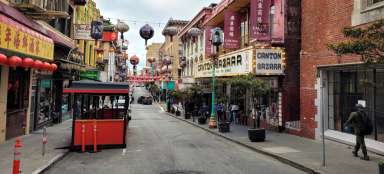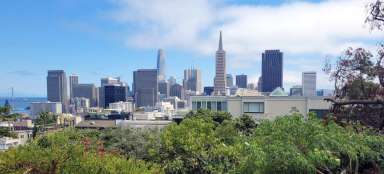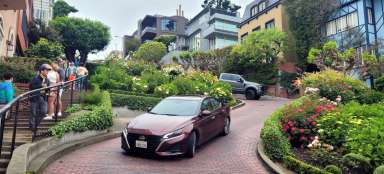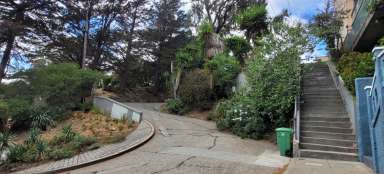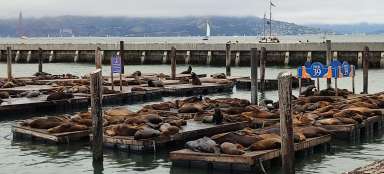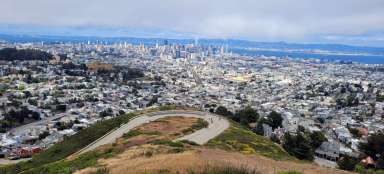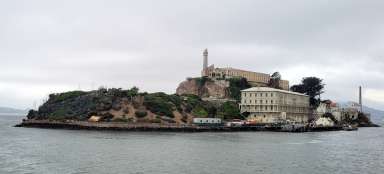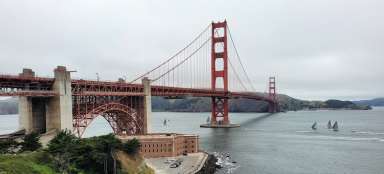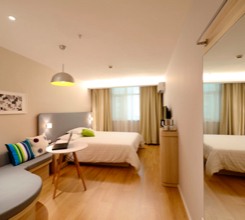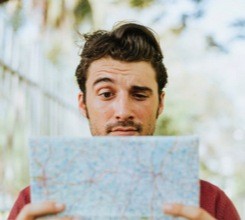The last manually operated trams in the world
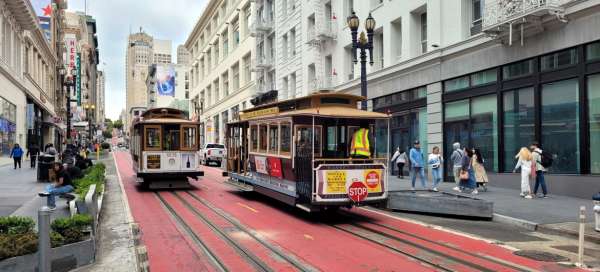
A ride on a historic tram is one of the most popular tourist attractions. Cable trams are one of the inseparable symbols of the city and carry more than seven million passengers every year. Although trams are part of the regular urban public transport system and are partly used by local residents, the majority of passengers are tourists.
San Francisco's cable car system is the last working manually operated system of its type in the world. Of the original more than twenty lines, only three lines are in operation today.
It's not about trams
Although these vehicles are called trams, they are not actually classic trams. This is because trams are powered by electric motors in the car, while these vehicles are pulled by a rope placed under the road. After all, in English they are called cable car.

Driving vehicles by rope
Historical cars use a rope to move, which is stretched in a shaft under the road along the entire length of the route. The rope is wound from a centrally located machine room. The driver (grip man) uses the control lever to „grip“ the moving rope, thereby setting the tram in motion; when stopping, the car then „disengages“ from the rope and brakes using the brakes. The speed of the vehicle is thus determined by the speed of the rope movement, which is stable – 15.3 km/h.
Therefore, controlling the vehicle on steep hills with many junctions is very challenging.

Very steep sections
Some of the sections are really very steep and if you're sitting in the front you might be holding your breath and hoping the brakes on the old car are fine..
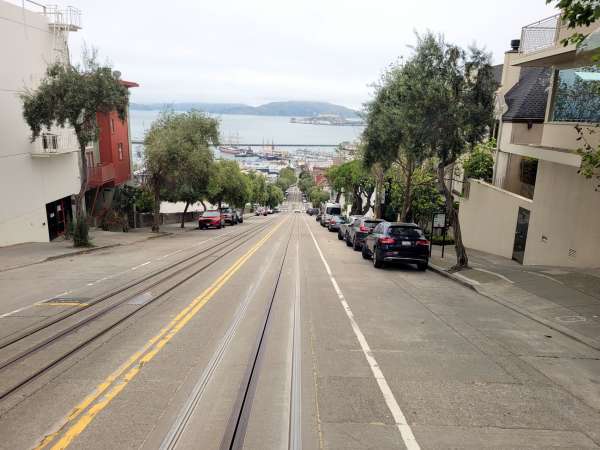

Manual vehicle control
Driving a vehicle is a demanding activity that requires experience, skill and physical fitness. The driver has two large levers at his disposal to control the movement of the tram in heavy traffic on very steep city streets. He handles them directly in the passenger cabin and it is therefore necessary for the driver to have enough space around him. The driver's space is marked on the platform on the floor of the vehicle and passengers must always vacate it.
One lever controls the jaws that press against the tow rope, while the other lever controls the brakes on the vehicle's wheels. The driver negotiates with the conductor using a cable that controls the bell.
History of San Francisco Streetcars
Due to the extremely steep hills in the city, horse-drawn carriages could not pass some sections. Therefore, it was decided to put the cable cars into operation.
The first cable car started already in 1873. The number of lines then increased rapidly and soon reached a total of twenty-three. However, with the passage of time, electric cars began to gain ground for operational reasons. In addition, a major earthquake in 1906 severely damaged the cable system. In 1912, therefore, only three lines remained in operation, and this only because some steep hills cannot be driven up by electrically powered trams.
It would have been possible to use these sections with buses, but in the end it was decided to keep these historic cars in service.

Turnstiles at the end of the lines
Since the control of the vehicles is only on one side, it is necessary to turn the cars at the end of the track. It is not ensured by a loop like with regular trams, but by an exact one, where the operator turns the vehicle on the spot. It is done by hand, which is a very attractive sight for tourists.

Long queues waiting
There are often long queues of tourists eager for a ride at the tram's final stops. Some tourists therefore try to board one or more stations further. However, it is not certain if they will manage to cram into the car. The ticket can be bought in the car.
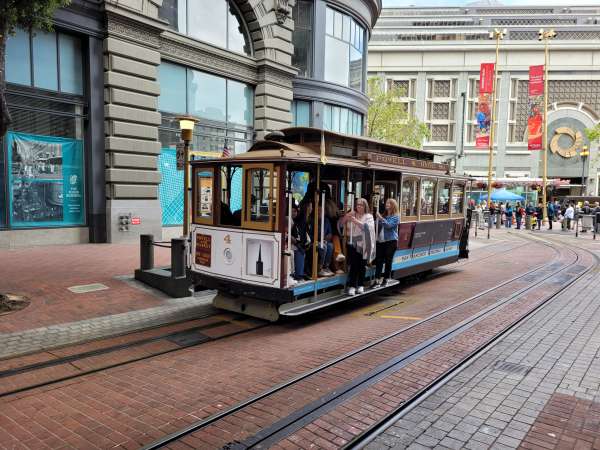

Vehicle interior
There are places to stand and sit in the vehicle. Seats in the longitudinal direction of travel and the cabin is divided into a closed and an open platform with seats. The carriages are partially open and the weather in San Francisco is windy, so it is advisable to have enough clothing even in warm weather.
Riding on a step
Trams allow an adrenaline-filled ride on the steps on the sides of the vehicle. Be very careful in bends and when passing vehicles!
The number of places on the steps is limited, first come, first served will have a better position and experience!
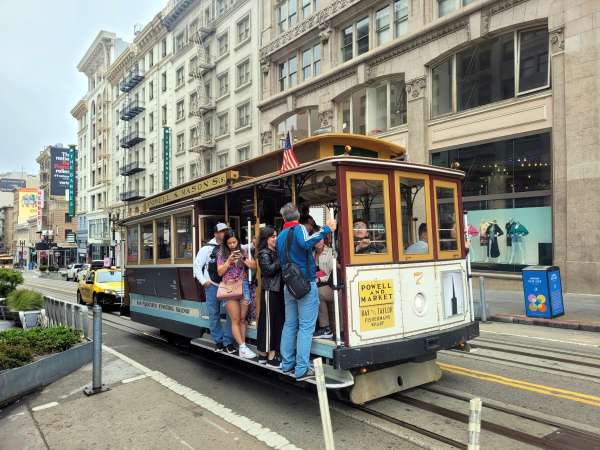
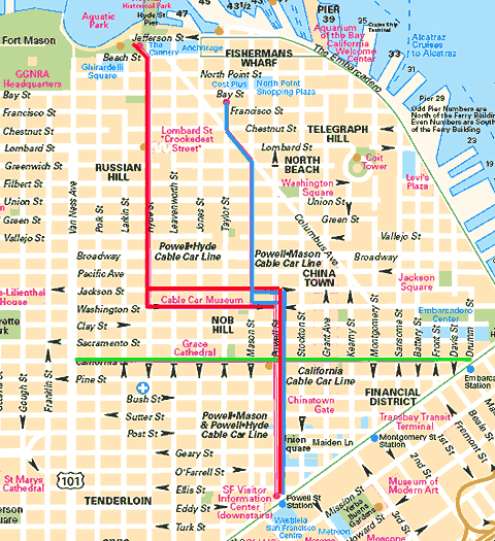
Tram lines
There are three lines in operation:
Powell/Hyde Line: Connects the intersections of Powell/Market and Hyde/Beach Streets
Powell/Mason Line: Runs between Powell/Market and Taylor/Bay.
California Line: Runs from the intersection of California/Drumm to California/Van Ness
The name of the route is printed on the sides of the streetcars (POWELL & HYDE, POWEL & MASSON, CALIFORNIA).
The Powell-Hyde (red) and Powell-Mason (blue) tracks offer you the most beautiful scenic drives in San Francisco.
On both Powell routes (red and blue), sit facing east for the best view during the ride.
On the Powell-Hyde line (red), you can get off at what is said to be the world's most winding street, Lombard Street.
The two main lines—Powell/Hyde and Powell/Mason—have a similar route; both begin at the intersection of Powell Street and Market Street and run towards the bay to the Fisherman's Wharf area.
The third line, which, unlike the first two, does not run north-south, but west-east, is California-Van Ness. This streetcar is reversible, so there is no turnpike at the terminus like the Powell-Mason and Powell-Hyde lines. This line is popular with tourists because it goes around Chinatown.
Tram stops
Each of the historical lines has many stops where you can get on and off at will. Tourists usually prefer to drive the entire route and get on at the final stop. Trams are often so full that you rarely get on at the stops along the way.
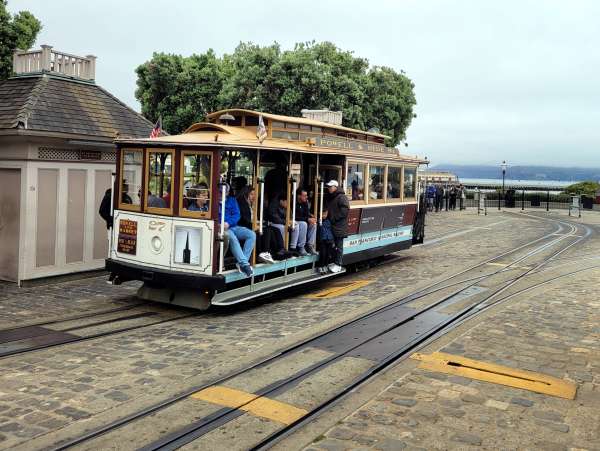
Which line is the most interesting for tourists?
The Powell-Hyde red line is probably the most interesting from a tourist point of view, and I recommend starting at the final stop, where there is a unique tram turnpike. The wagons on it are turned manually by human power. You will most likely spend a few tens of minutes in line for a ride, but you will be sure to get a ride. Boarding at other stops depends on the occupancy of the passing tram and you may not be able to board anywhere.
For the best view of the bay, it's a good idea to stay on the east side after getting into the car (applies to the Powell/Mason and Powell/Hyde lines) – i.e. to the right when driving from the center towards the bay, and to the left if traveling in the opposite direction.
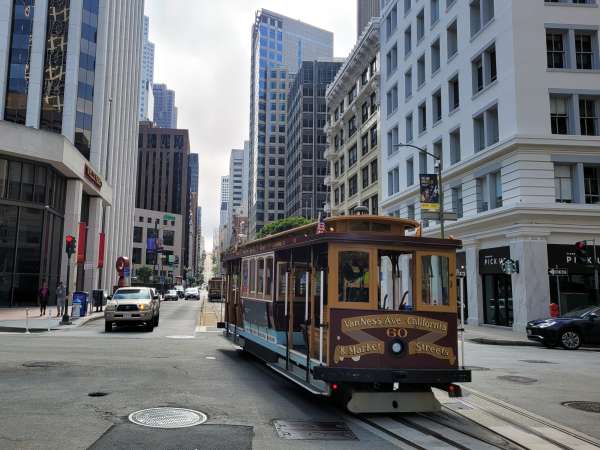
Powell stop
For tourists, it is probably best to get on the tram at the Powell stop, which is right next to the subway exit. But you have to be careful and get on the right line, because both the red line and the blue line depart from there.

How much does a tram ride cost?
The price of a single cable car ticket is 8 USD. It is possible to buy an all-day ticket. It's not cheap, but it's definitely worth it.
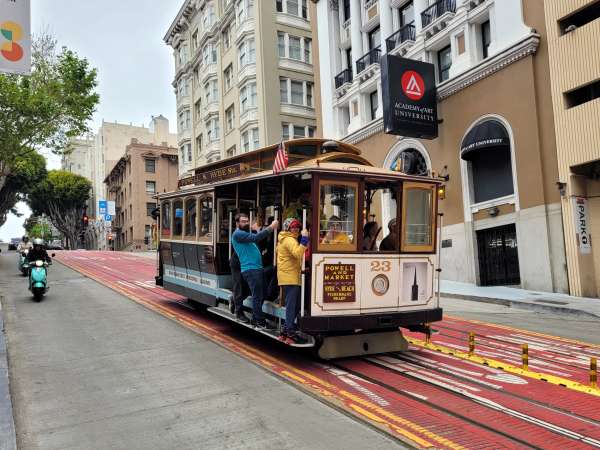
Articles nearby
Giga List: San Francisco - what to see
San Francisco is considered the most beautiful city on the west coast of the USA. There is so much to see, visit and experience… continue reading





